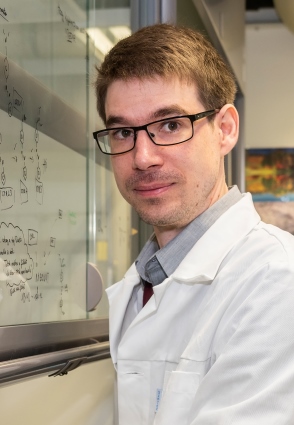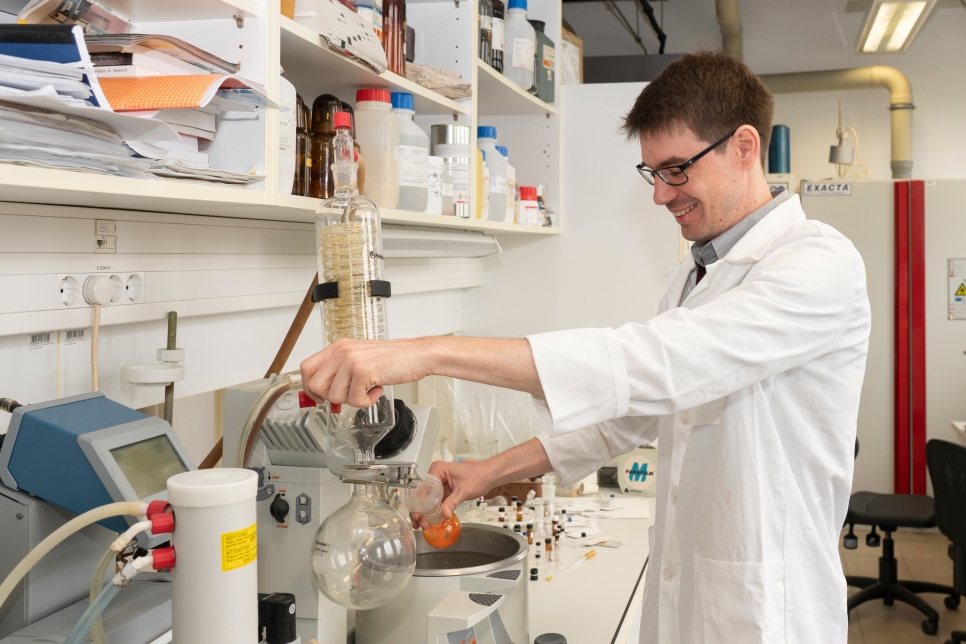Gábor London’s project proposal on how useful work could be harnessed from assemblies of molecules functioning as switches awarded funding by the evaluation panel under the call announced by the NRDI Office in 2017 for thematic applications initiated by young researchers. Molecular machines and switches can be used, for example, in medicine, as computer memory elements or even in mobile phone coatings that self-repair their scratches. Gábor London, research fellow at the Institute of Organic Chemistry of the Research Centre for Natural Sciences of the Hungarian Academy of Sciences (RCNS HAS) and recent recipient of the Youth Award of HAS, learned the “profession” at the right place: his PhD supervisor, Ben Feringa was awarded the Nobel Prize in Chemistry in 2016.

Gábor London, research fellow at the Institute of Organic Chemistry of the HAS Research Centre for Natural Sciences
The FK_17 call for young researchers aims to provide funding to talented young researchers (under 40 years of age) who want to establish an independent research group to start their own independent discovery research project. The call is not bound by any thematic priority and is not restricted to any area of science. Applications can relate to any kind of discovery research, if otherwise the application meets the conditions laid down in the call. The call is financed from the National Research, Development and Innovation Fund.
When did you get acquainted with molecular motors?
In 2006, right at the time when research into their practical implementation began. Ever since, we have been working in the Netherlands towards being able to see the effects of molecular movements also on macroscopic level. It is very hard to detect structural changes in a single layer of molecules but, for example, through the shape of a water droplet on such a layer we can see if we change something in the underlying layer of molecules: if we increase the wetting of the surface by changing the structure of the molecules, the droplet will flatten and if we reduce it, then the droplet will take a rounder shape. We can control this phenomenon at the molecular level.
A number of nanotechnology research projects are aiming to minimize the size of electronic devices or to create capsules delivering active pharmaceutical ingredients to the target. These systems can be operated with tiny dynamic elements. For example, we can switch the flow of electrons on and off in a molecular circuit with the help of molecular switches. And if a capsule contains dynamic molecular elements, the active pharmaceutical ingredient can reach its target and the capsule will only fall apart upon some kind of external stimulus that we can control. . Then the molecules will change their shape, polarity, acid/base or redox characteristics thus activating a tiny, almost invisible system.
Does this current project enable you to work with such systems also in Hungary?
Yes. In the past three years, I have submitted several proposals in this topic - and this is the first I won. This project focuses on switches, functional organic materials.
Is this work something so new?
No, it is becoming an increasingly explored topic and has the potential of making unexpected discoveries. In other countries entire institutes are established for the research of molecular machines. One of the obstacles to get funding may have been that this field was not present in Hungary earlier, on the other hand, it is rather costly while the success rate is rather low. It requires a large infrastructure and, for synthesizing the molecules, a lot of hard-working students: four to five people had been working for several years on the nanocar included in the Nobel Lecture presentation. It was said they could have bought three cars (and not cheap and shabby ones) from the money they had spent on that tiny car.
What is this current project aspiring to achieve?
One of the main approaches in developing molecular motors and switches for applications is not to let them float around in solution so that their movements are uncontrolled due to diverse thermal effects, instead we should try to reduce this freedom of the molecules by confining them to a carrier surface. This way we can restrict the movements of molecules to the movements we induce in a controlled manner. And if we attach a lot of molecules to a surface, then we can set this ensemble to work. This is what we want to achieve.
Today it is rare that various light-driven molecules are operated on a surface and the different types of molecules can be activated by various wavelengths of light. We are planning to produce such systems because, for example, we would like to control when and where the molecules are activated on the surface. By combining different wavelengths of light, we can produce gradients, so we can gradually transform a water-resistant surface, for instance, into a highly wettable one. It may be useful, for example, in building microfluidic systems where fluid droplets are needed to move but, due to size constraints, pumps cannot be used. If we change the fluid’s affinity to the surface, then we can move the fluid from point ‘A’ to point ‘B’: we can manipulate microscopic systems containing fluids.
Where is it needed?
For example, in blood testing – and all it requires is to direct light to the adequately prepared surface.
Similar surfaces can also be used as a sensor: for example, they can bind biomolecules or larger proteins depending on which functional group we make available on the surface.
I have already mentioned nanosystems that can be applied in medicine. Here the general objective is to combine diagnostics with therapy. With their help we can not only cure but also map the areas affected by a disease: the tasks are executed through the coordinated operation by lots of molecules on a nanoparticle. One of them, for example, identifies a tumour and binds to it. Then another one lights up and an external imaging device locates the problem. Another molecule is responsible for the therapeutic effect. For this, it is not enough to design dynamic molecules but we also have to make sure that the molecules function well also on the surface of nanoparticles. Medical research based on nanoparticles are, actually, conducted also at RCNS HAS.
So, we are engaged in developing systems containing molecules that can be activated in different ways and are integrated and produce their effects on a carrier material. This requires the synthesis of large numbers of molecules, and control measurements.
Coordinating the organic molecules and their carriers is a multidisciplinary research. Who are you working together with?
With everybody.... Luckily, almost all infrastructure is available at RCNS HAS. Our main profile is synthesis: we spend about 70% of our time with producing molecules. We are rather new in the Institute of Organic Chemistry so our stock of chemicals is still small but many of the researchers are generous to share materials with us. Synthesis is followed by characterisation (we have to check whether our molecules are moving), in this we are assisted by our colleagues from the Institute of Materials and Environmental Chemistry of RCNS HAS and the catalysis researchers of the University of Szeged.
Do you maintain contact also with your Dutch colleagues?
We have started to work on the switch system in the past one to one and a half years, increasingly getting into cooperation with former colleagues. Some measurements can only be carried out in the Netherlands and our first joint results are expected to be published soon. It is good to feel how personal links are reopened with many old friends while working. For example, I have a Chinese friend who became dean at a university in Shanghai.
It is about international networking, isn’t it...?
We are trying to strengthen our relations through applications for mobility grants and international cooperation grants to allow also our students to gain experience abroad. This is crucial for their development. One of my students visited Sweden after Easter to learn computational chemistry tools that is indispensable for our work, another student will hopefully soon can go to the Netherlands to learn an electrochemical technique useful for us.
How many people do you have in your group?
I am working with a PhD student who takes the workload of a postdoctoral researcher. The team also comprises four MSc and two BSc students. All of them are very enthusiastic and, as I see, they enjoy playing with these molecules. I am happy to see them happy because happy people work better.







